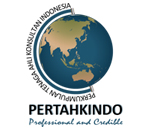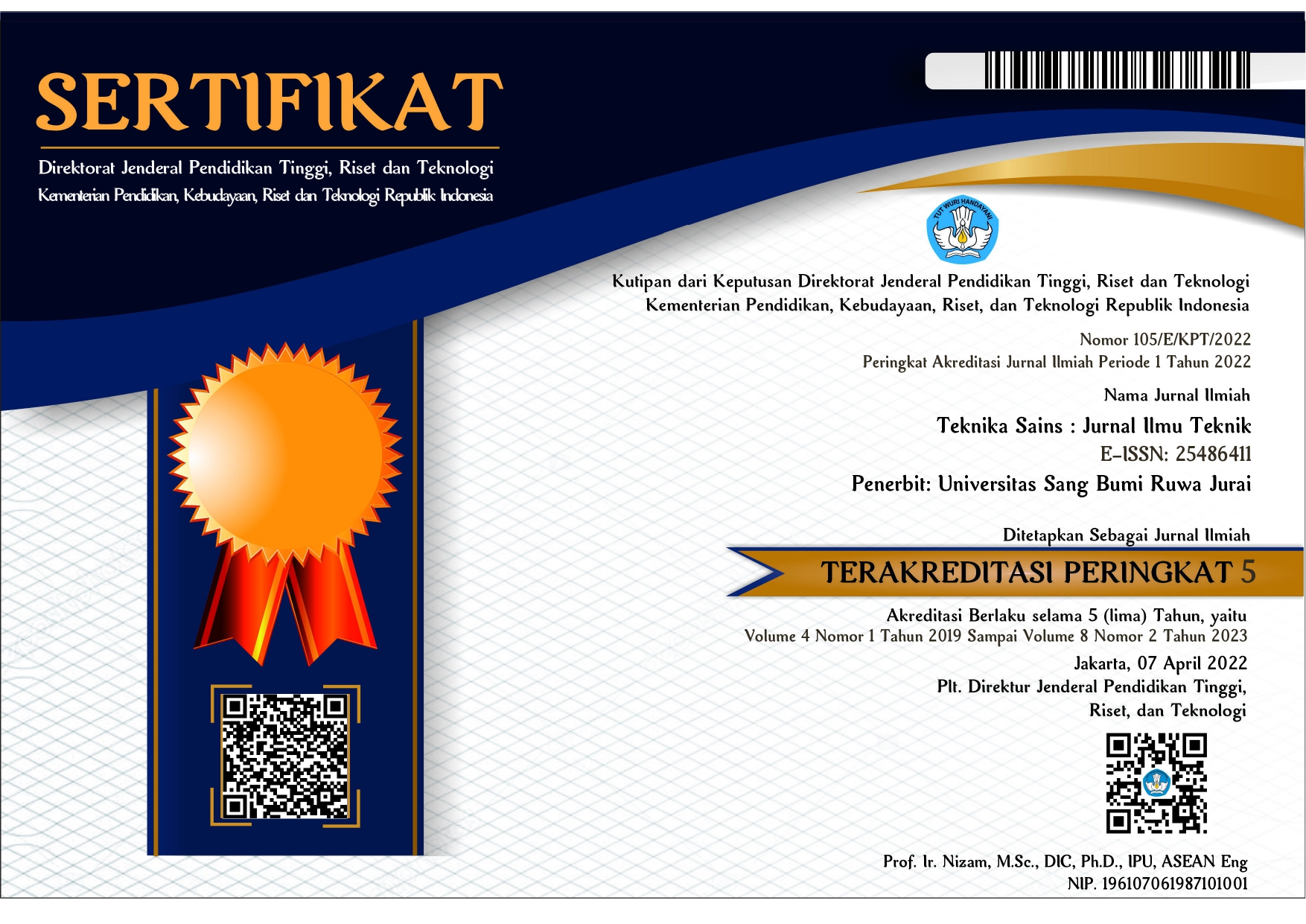PENGARUH ZAT ADITIF TERHADAP KUAT TEKAN BETON K-225 MENGGUNAKAN BATU BASALT SCORIA
Abstract
Indonesia is a developing country that is doing a lot of development in all areas such as: the construction of buildings, bridges, dams, canals, and others. Various studies and experiments in the concrete field are carried out as an effort to improve the quality of concrete, material technology and implementation techniques obtained from the results of research and experiments intended to answer the increasingly high demands on the use of concrete and overcome the obstacles that often occur in the implementation work at outdoor. The use of added materials (Admixture) can help solve these problems. The purpose of this study was to determine the extent of the influence of additives on the compressive strength of k-225 concrete using basalt scoria stone. The making of k-225 concrete used cuboid sized molds (15cm x 15cm x 15c) in research into the manufacture of concrete to produce high quality concrete. The research method used was an experimental method conducted at the laboratory of PT. Gig Polah Raya Jl. Lintas Sumatera KM 22 Sukabandung South Lampung, namely by carrying out or physically experimenting on concrete tests, which used additives, as many as 24 test objects, namely 6 without additives and 6 additives 0.45%, and 0.55% and 0.63% and normal compressive strength k-225. The aim is to know the average compressive strength between normal concrete and concrete using a mixture of additives as a reference.
References
ASTM-C494. (2017). Standard Specification for Chemical Admixtures for Concrete. West Conshohocken, PA: ww.astm.org.
Bondan SDR. (2019, 07 16). Teknik Pengujian Kuat Tekan Beton. Retrieved from Indo Digital: https://indo-digital.com/teknik-pengujian-kuat-tekan-beton.html
ESDM. (2015). Indonesia Mineral and Coal Information 2015. Jakarta: Direktorat Jendral EDSM Republik Indonesia.
Herdiansyah, & Pangaribuan, M. R. (2013). Pengaruh Batu Cadas (Batu Trass) Sebagai Bahan Pembentuk Beton Terhadap Kuat Tekan Beton. Jurnal Inersia Vol.5 No.2, 12.
Ilmugeografi. (2016, November 21). Batu Basal : Pengertian, Proses dan Jenisnya. Retrieved from Website Pusat Studi Geografi Indonesia: http://ilmugeografi.com/geologi/batu-basal
Kadhafi, M. (2015). Pemanfaatan Coppers Slag sebagai Subtitusi Semen pada Campuran Beton Mutu K-225. Jurnal Teknik Sipil dan Lingkungan Vol. 3, No. 1, 734-740.
Kasjono. (2009). Analisis Multivariat untuk Penelitian. Jakarta: Andi Offset.
Militinky, J., & Kovacic, V. (1996). Ultimate Mechanical Properties of Basalt Filaments. Texs. Res. J. 66 (4), 225-229.
Munir. (2017, Desember 12). Jenis-Jenis Additive untuk Meningkatkan Mutu Beton. Retrieved from https://www.gurusipil.com: https://www.gurusipil.com/jenis-jenis-additive-untuk-meningkatkan-mutu-beton/
Shrivastav, P. K., & Tare, K. (2015). Basalt Fibre Reinforced Concrete an Alternative to the Synthetic Fiber Reinforced Concrete. IJSRD - International Journal for Scientific Research & Development Vol. 3, Issue 01, 316-319.
Wang, C.-K., & Charles, S. (1993). Desain Beton Bertulang. Jakarta: Erlangga.
Widojoko, L., & Rajiman. (2011). Kinerja Mortar Abu Batu Basalt Scoria dengan Menggunakan Semen Serbaguna Baturaja dan Superplasticiser Structuro 335. Jurnal Teknik Sipil UBL Vol. 2 No. 1, 79-87.
 DOI: https://doi.org/10.24967/teksis.v3i1.607
DOI: https://doi.org/10.24967/teksis.v3i1.607
Article Metrics
 Abstract view : 1565 times
Abstract view : 1565 times
 PDF (Bahasa Indonesia) : 0 times
PDF (Bahasa Indonesia) : 0 times
Refbacks
- There are currently no refbacks.
Abstract
Indonesia is a developing country that is doing a lot of development in all areas such as: the construction of buildings, bridges, dams, canals, and others. Various studies and experiments in the concrete field are carried out as an effort to improve the quality of concrete, material technology and implementation techniques obtained from the results of research and experiments intended to answer the increasingly high demands on the use of concrete and overcome the obstacles that often occur in the implementation work at outdoor. The use of added materials (Admixture) can help solve these problems. The purpose of this study was to determine the extent of the influence of additives on the compressive strength of k-225 concrete using basalt scoria stone. The making of k-225 concrete used cuboid sized molds (15cm x 15cm x 15c) in research into the manufacture of concrete to produce high quality concrete. The research method used was an experimental method conducted at the laboratory of PT. Gig Polah Raya Jl. Lintas Sumatera KM 22 Sukabandung South Lampung, namely by carrying out or physically experimenting on concrete tests, which used additives, as many as 24 test objects, namely 6 without additives and 6 additives 0.45%, and 0.55% and 0.63% and normal compressive strength k-225. The aim is to know the average compressive strength between normal concrete and concrete using a mixture of additives as a reference.
References
ASTM-C494. (2017). Standard Specification for Chemical Admixtures for Concrete. West Conshohocken, PA: ww.astm.org.
Bondan SDR. (2019, 07 16). Teknik Pengujian Kuat Tekan Beton. Retrieved from Indo Digital: https://indo-digital.com/teknik-pengujian-kuat-tekan-beton.html
ESDM. (2015). Indonesia Mineral and Coal Information 2015. Jakarta: Direktorat Jendral EDSM Republik Indonesia.
Herdiansyah, & Pangaribuan, M. R. (2013). Pengaruh Batu Cadas (Batu Trass) Sebagai Bahan Pembentuk Beton Terhadap Kuat Tekan Beton. Jurnal Inersia Vol.5 No.2, 12.
Ilmugeografi. (2016, November 21). Batu Basal : Pengertian, Proses dan Jenisnya. Retrieved from Website Pusat Studi Geografi Indonesia: http://ilmugeografi.com/geologi/batu-basal
Kadhafi, M. (2015). Pemanfaatan Coppers Slag sebagai Subtitusi Semen pada Campuran Beton Mutu K-225. Jurnal Teknik Sipil dan Lingkungan Vol. 3, No. 1, 734-740.
Kasjono. (2009). Analisis Multivariat untuk Penelitian. Jakarta: Andi Offset.
Militinky, J., & Kovacic, V. (1996). Ultimate Mechanical Properties of Basalt Filaments. Texs. Res. J. 66 (4), 225-229.
Munir. (2017, Desember 12). Jenis-Jenis Additive untuk Meningkatkan Mutu Beton. Retrieved from https://www.gurusipil.com: https://www.gurusipil.com/jenis-jenis-additive-untuk-meningkatkan-mutu-beton/
Shrivastav, P. K., & Tare, K. (2015). Basalt Fibre Reinforced Concrete an Alternative to the Synthetic Fiber Reinforced Concrete. IJSRD - International Journal for Scientific Research & Development Vol. 3, Issue 01, 316-319.
Wang, C.-K., & Charles, S. (1993). Desain Beton Bertulang. Jakarta: Erlangga.
Widojoko, L., & Rajiman. (2011). Kinerja Mortar Abu Batu Basalt Scoria dengan Menggunakan Semen Serbaguna Baturaja dan Superplasticiser Structuro 335. Jurnal Teknik Sipil UBL Vol. 2 No. 1, 79-87.


Teknika Sains: Jurnal Ilmu Teknik is licensed under a Creative Commons Attribution-ShareAlike 4.0 International License












 Cahya Sujatmiko
Cahya Sujatmiko